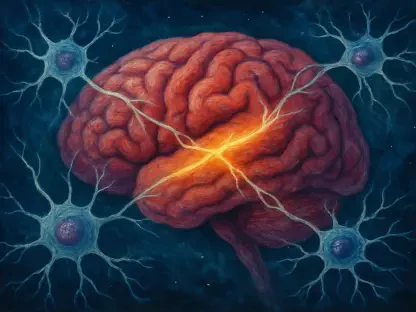In the evolving landscape of medical imaging, technological advancement holds immense potential in transforming global healthcare outcomes. Dr. Ge Wang stands at the forefront of this transformation, contributing significantly through his work in X-ray computed tomography (CT) and artificial intelligence (AI) integration for medical imaging. Recognized for his leadership, research, and mentoring prowess, Dr. Wang has been honored with the prestigious Edith H. Quimby Award, acknowledging his lifetime achievements in medical physics. This article delves into Wang’s innovative contributions, guiding principles, and the profound impact of his work on both science and medical practice.
Transformative Contributions to Medical Imaging
Pioneering Cone-Beam Spiral CT Technology
Dr. Wang’s groundbreaking contributions include the development and enhancement of cone-beam spiral CT technology, which has become integral to contemporary medical diagnostics. Each year, this methodology is used in over 375 million CT scans worldwide, emphasizing its pivotal role in modern healthcare. This system’s ability to accurately visualize complex anatomical structures has not only advanced diagnostic capabilities but also drastically improved treatment planning and patient outcomes globally. His innovation extends beyond traditional imaging by utilizing AI to fine-tune imaging techniques, optimize algorithms, and reduce patient radiation exposure, thereby revolutionizing everyday clinical practices.
The motivation for Dr. Wang’s work often stems from personal experiences, such as seeking advancements that could aid in medical procedures, inspired by events like his mother’s surgery. This perspective drives him to address challenges directly relevant to improving care and patient quality of life. By focusing on enhancing image quality and reducing radiation exposure, his AI-based methods have significantly contributed to safer diagnostic procedures, positioning low-dose CT as a more viable option for a broader range of patients. Consequently, his work ensures both improved clinical outcomes and a more patient-centered approach to medical imaging.
Integration of AI in Medical Imaging
Dr. Wang’s efforts have not only transformed existing imaging techniques but have also laid a solid foundation for the integration of AI in medical imaging applications. With his deep-learning CT denoising techniques, he has created a new paradigm that balances high-quality images with minimal resource usage, allowing for quicker and more accurate diagnoses. By developing sophisticated algorithms to enhance image recognition and interpretation, Wang’s contributions have set a new benchmark in precision and efficiency for radiologists and healthcare practitioners.
Furthering this integration, his work adapts cutting-edge AI technology to existing imaging systems to enable real-time analysis and decision-making. This advancement is critical in emergency situations, where time-sensitive diagnoses are paramount. His extensive collaboration with academic and industry leaders has led to the proliferation of these technologies, illustrating how AI can successfully complement human expertise in medical diagnostics. Through these efforts, Dr. Wang continues to inspire ongoing innovation, pushing the boundaries of what is possible in medical imaging and setting a course for future technological advancements.
Leadership and Mentorship in the Field
Educational Impact and Mentoring Achievements
Beyond his technical innovations, Dr. Wang’s influence extends to his roles as an educator and mentor, where he has guided over 100 students, fostering future leaders in medical imaging and related fields. His commitment to academic rigor and scientific communication aims to develop skilled professionals equipped to drive innovation in healthcare technology. By nurturing talent and curiosity, Wang cultivates a learning environment that encourages exploration and inventive thinking among students, resulting in next-generation solutions to complex medical challenges.
Central to his educational philosophy is the development of learning resources and platforms that support the acquisition of practical knowledge and skills. Wang’s creation of the first textbook focused on machine learning for tomographic imaging is a testament to his dedication to both advancing knowledge and making technical concepts accessible. This work not only supports those currently pursuing expertise in medical imaging but also serves as a foundational resource for future advancements in the field. Wang’s mentorship philosophy emphasizes the importance of collaboration, innovative thinking, and lifelong learning, fostering a culture where emerging professionals are prepared to influence and improve medical practices globally.
Recognition and Professional Honors
Dr. Wang’s distinction in medical imaging is underlined by his robust catalog of over 700 publications and 170 patents, which encapsulate his career’s prolific output and varied innovations. His contributions have been recognized through numerous awards, including the IEEE EMBS Academic Career Achievement Award and the SPIE Meinel Technology Achievement Award, cementing his position as a luminary in the field. Additionally, his role as Editor-in-Chief of IEEE Transactions on Medical Imaging illustrates his influence over the direction of research and innovation across the industry.
By contributing thought leadership through editorial roles, Dr. Wang actively shapes the discourse within medical imaging, encouraging the community to challenge existing paradigms and explore novel concepts driven by science and technology. His influence extends beyond the academic realm, resonating within professional organizations and technological industries that rely on his insights to inspire new generations of research and application. As his achievements are formally recognized at the AAPM Annual Meeting in Washington, D.C., the impact of his work will be celebrated, providing a platform to reflect on his contributions and inspire future breakthroughs.
A Legacy of Innovation and Inspiration
In the rapidly advancing field of medical imaging, technology has the potential to revolutionize healthcare globally. Dr. Ge Wang is a leading figure in this transformation, making significant contributions with his pioneering work in X-ray computed tomography (CT) and the integration of artificial intelligence (AI) in medical imaging. His expertise positions him prominently as he shapes the future of diagnostic methods. Dr. Wang’s efforts and accomplishments have earned him the esteemed Edith H. Quimby Award, a testament to his lifelong contributions to medical physics. This recognition underscores his proficiency in leadership, research, and mentoring. This discussion explores Wang’s groundbreaking contributions and guiding principles. The article also examines the profound and lasting influence of his work on the scientific community and medical practices. Dr. Wang’s relentless pursuit of innovation has not only advanced technology but has also improved the quality of patient care across the world.









